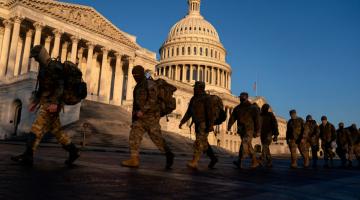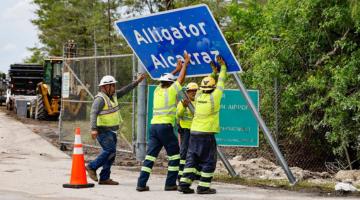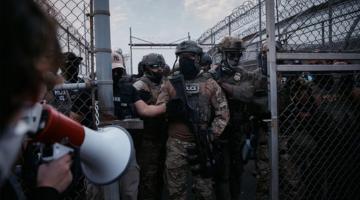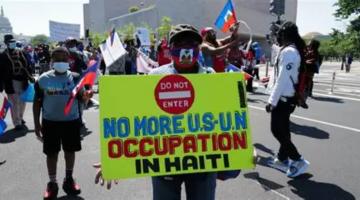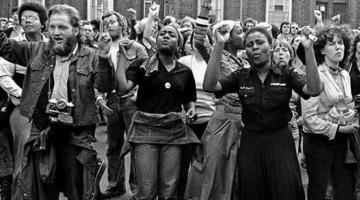Immigrant rights protesters outside of the District Court for the District of New Jersey (Photo: Make the Road New Jersey)
The Trump administration opens a new ICE detention center in New Jersey’s biggest city and a hub for immigrant communities, earning a bold response from immigrant rights organizers.
Originally published in People's Dispatch.
In February, the US Immigration and Customs Enforcement (ICE) announced that it would be reopening the shuttered Delaney Hall halfway house on the outskirts of Newark, New Jersey as the first new immigrant detention center to open during Trump’s second term. At the time, few could have anticipated that it would open up a new front in the struggle against mass deportations – but the newly minted detention center has now been launched into the spotlight by a wide array of New Jersey residents, activists and political leaders.
These organizers have participated in ongoing protests against the detention center, which reopened on May 1 and organizers claim violates New Jersey law. On May 9, ICE agents went so far as to retaliate to a protest and site visit by elected officials by arresting Newark Mayor Ras Baraka.
Despite the arrest of Newark’s mayor, immigrant rights organizers have not stopped protesting outside of the detention center, and vow to continue fighting back until “ICE is fully out of our state,” says Viri Martinez of the New Jersey Alliance for Immigrant Justice.
Trump administration panics as mass deportation quotas are unmet
During his campaign, Trump has vowed to undertake the largest mass deportation operation in US history, with promises to deport up to 20 million immigrants. But in reality, his administration has run into a number of obstacles in carrying out this drastic operation, including the limited capacity of existing ICE detention centers.
With deportation numbers projected to fall well short of the Trump administration’s stated goal of one million deportations per year (a process which the American Immigration Council has estimated would cost one billion annually), the president has tried to speed up the process, with DHS seeking an additional 20,000 National Guard troops for border enforcement.
Officials with the Department of Homeland Security claim to be working with the Marshals Service, Department of Defense and Federal Bureau of Prisons to increase bed space, as well as asking Congress for more funding.
Trump’s desire to meet his quote of one million deportations has another key obstacle: the legal system. In order for immigrants to finally be deported, it is not enough to simply arrest and detain them, they must go through court proceedings. Trump has sought to bypass due process as much as he possibly can, but while the legal process continues to exist, the Trump administration has opted to hold the hundreds of migrants arrested on a daily basis in detention centers, but neither the existing detention centers have capacity, nor are the courts moving at the speed that he would like. Trump’s response? Build more detention centers and look for ways to deport people by circumventing the courts – such as through the invocation of the 1798 Alien Enemies Act.
On February 26, ICE announced that it was reopening a former halfway house in New Jersey as the first new detention facility to open under the Trump administration. The Delaney Hall Facility, with its location near the Newark International Airport, “streamlines logistics, and helps facilitate the timely processing of individuals in our custody as we pursue President Trump’s mandate to arrest, detain and remove illegal aliens from our communities,” said acting ICE Director Caleb Vitello in a statement.
To reopen Delaney Hall, ICE struck a USD 1 billion dollar deal with GEO Group, one of the for-profit corporations which runs ICE detention centers throughout the country. The deal was immediately condemned by immigrant and civil rights organizations, including the American Civil Liberties Union (ACLU) of New Jersey. The new detention facility would pose “a serious threat to New Jersey’s immigrant communities and is one of the largest immigration detention contracts our state has ever seen,” wrote ACLU-NJ Executive Director Amol Sinha in a statement.
“We have been in the struggle against detention centers in New Jersey for more than a decade,” said immigrant rights organizer Ana Paola Pazmiño, the executive director of Resistencia en Accion NJ. “We’re very alarmed by this new center at Delaney Hall opening up, and operating with city ordinances and inspection and occupancy certificates that have not been issued.”
Struggle builds against Delaney Hall reopening
New Jersey’s political leaders quickly got involved in the struggle against the reopening of the newly-minted 1,000-bed detention facility. Ras Baraka, the mayor of Newark, which is a major hub for New Jersey’s immigrant communities as well as a sanctuary city which limits collaboration with federal immigration authorities, sued GEO Group, claiming that the company did not have the proper permits to renovate and that city inspectors had been barred from the facility.
Baraka has also joined protests outside of the facility, which resulted in national headlines when he was arrested by federal immigration agents at one such protest on May 9, later released and charged with trespassing. Baraka was with three other New Jersey elected officials when he was arrested – Congressional Representatives Bonnie Watson Coleman, Rob Menendez and LaMonica McIver.
A DHS press release claimed that protesters, which included Baraka and other politicians, had “stormed the gate and broke into the detention facility,” which Baraka has denied. The Newark mayor has circulated video footage showing him being let into the facility’s gates. Mayor Baraka has continued to protest outside the facility despite facing misdemeanor trespassing charges, vowing to return next week.
WATCH: ICE agents let N.J. mayor through facility gates. He says he wasn’t trespassing.
Read now: https://t.co/x67KzFam1p
— City of Newark (@CityofNewarkNJ) May 14, 2025
Immigrant communities overcome fear to keep protesting
Viri Martinez, an immigrant rights organizer with the New Jersey Alliance for Immigrant Justice, was at the protest in front of Delaney Hall when Mayor Baraka was detained. “I was there when fully armed ICE agents swarmed through the gate and took an elected official, and threw down one of my organizers to the ground and pinned her down.”
But nonetheless, Martinez feels pride “in our movement,” after witnessing the arrests, “and to see regardless, our communities continuing to stand up in the face of an authoritarian fascist regime.”
Immigrant rights organizations in New Jersey have shared photos of the increased militarization and escalation of security outside of Delaney Hall this week, including the presence of armored vehicles.
Li Adorno, an organizer with Cosecha New Jersey, describes that the immigrant rights movement has long been pushing for all detention centers to close in the state, “because we have seen that they have brought nothing to our communities other than discrimination and oppression.”
Ana Paola Pazmiño of Resistencia en Accion NJ outlines that a new detention center opening so close to the Newark airport “is an alarming matter, because as we have seen in previous cases, people are not given due process, they’re not given the right to go before a judge and they are instead deported right away.”
“I think the nation is looking at New Jersey in the capacity of how we can fight the opening of detention centers,” Pazmiño told Peoples Dispatch.
“We will continue fighting until ICE is out of our state,” Viri Martinez told Peoples Dispatch. “We will continue fighting until you know there are no more deportations, there is no more detention, until our families are no longer separated. We have been fighting this fight for a long time and we will continue until we win.”
Immigrant communities are facing “a lot of fear,” Pazmiño said. But she described an organizing victory she witnessed on Monday, May 12, in which “We were able to have at least two families go into [Delaney Hall] and visit their family members in the afternoon.” According to Pazmiño, these families have not been able to visit their detained loved ones “for weeks since, I believe, May 1, when the center started operating.”



